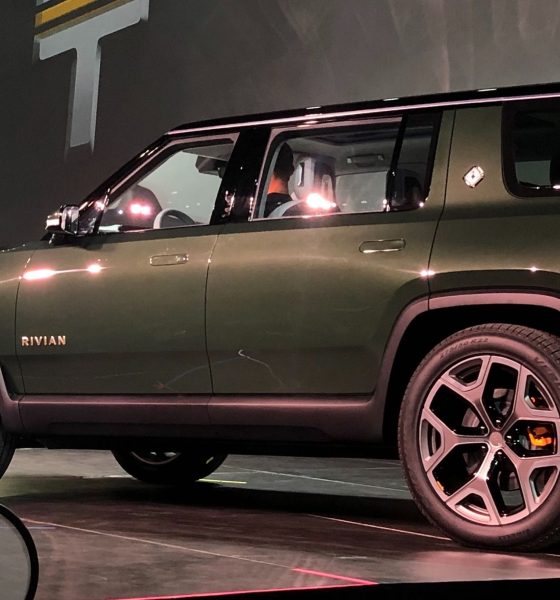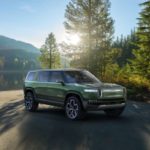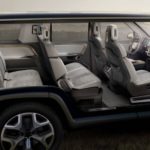

News
Rivian R1S: 7-seat, 410-mile SUV is taking on Land Rover in the luxury off-road game
Rivian CEO and founder RJ Scaringe is adopting a bold and strategic play to enter the auto industry. With the recently unveiled R1T electric pickup truck, Rivian is attempting to breach a market dominated by America’s best-selling vehicles like the Ford F-150. With the R1S SUV, which is set to be unveiled today at the 2018 LA Auto Show, the company is taking on pedigreed carmakers such as Land Rover in the luxury SUV segment.
The Rivian R1S, just like its pickup truck sibling, could be described as a luxury adventure vehicle. The SUV is fitted with the same four 147 kW electric motors that power the R1T, as well as the same 2170 battery cells. Similar to the startup’s pickup truck, the R1S is available in three battery configurations — a 105 kWh entry-level variant, a 135 kWh mid-level version, and a 180 kWh top-tier variant. Compared to the R1T, though, the R1S has slightly more range, with the 105 kWh trim having an estimated range of 240+ miles per charge, the 135 kWh version having 310+ miles of range, and the 180 kWh variant having 410+ miles of range in one charge.
Performance between the R1T and the R1S is identical, with 135 kWh SUV capable of traveling from 0-60 mph in 3 seconds flat. Keeping the company’s character, the R1S could go through up to 1 meter of water. That said, the two vehicles also have their differences.
- The Rivian R1S. [Credit: Rivian]
- The interior of the Rivian R1S. [Credit: Rivian]
- The Rivian R1S dashboard. [Credit: Rivian]
The Rivian R1S SUV. [Credit: Rivian]
The R1S, for one, has a slightly shorter wheelbase at 3,075 mm, which is less than the R1T’s 3,450 mm. Due to the absence of a bed, the R1S’s 5,040 mm overall length is also shorter than the R1T’s 5,475 mm length. Being a three-row SUV capable of seating seven, the R1S does not have as much storage as the R1T as well, with flourishes such as the pickup truck’s “gear tunnel” being absent on the vehicle. That said, the R1S is still capable of hauling a generous amount of cargo, thanks to its 330-liter frunk and its foldable third-row seats.
We asked the company why it opted to release an SUV together with its flagship pickup truck, considering that the SUV market is equally as dominated by big-name, veteran carmakers. Rivian noted that the risk for the R1S is actually quite low, considering that it shares 93% of the R1T pickup truck’s components. The company further pointed out that the SUV market has already been established, and the success of vehicles like the Tesla Model X, which is built on the Model S platform, has proven that cross-pollination is a viable strategy.
- The Rivian R1T and R1S take center stage at the 2018 LA Autoshow
- The Rivian RT1 and the R1S compared. [Credit: Rivian]
Teslarati‘s Christian Prenzler was able to get an early preview of the Rivian R1S prior to its unveiling, and he notes that the vehicle’s overall form and size seem to be similar to the Chevrolet Tahoe and the GMC Yukon. He also stated that the SUV has a liftgate at the rear, which gives passengers a place to sit on. The R1S’ third-row seats, which are usually cramped in conventional SUVs, are also adjustable, allowing passengers to gain more legroom in exchange for less luggage space.
Rivian CEO and founder RJ Scaringe stated that he wants the company’s vehicles to focus on the adventure niche. In this light, the R1S SUV and the R1T electric pickup truck complement each other well, allowing the company to enter two hyper-competitive segments with vehicles that have a serious punch.
“They may have different form factors, they may be different sizes, but every single one of [our products] has to have this Patagonia-like feel of enabling adventure. We want to keep that very sharp. We want to focus only on the adventure space, so customers understand what we stand for,” he said.
Reservations for the R1S SUV are now open. Interested customers can place a refundable $1,000 deposit for the vehicle here. Production is expected to begin in 2021.
With assistance from Christian Prenzler.

Elon Musk
Elon Musk’s X will start using a Tesla-like software update strategy
The initiative seems designed to accelerate updates to the social media platform, while maintaining maximum transparency.

Elon Musk’s social media platform X will adopt a Tesla-esque approach to software updates for its algorithm.
The initiative seems designed to accelerate updates to the social media platform, while maintaining maximum transparency.
X’s updates to its updates
As per Musk in a post on X, the social media company will be making a new algorithm to determine what organic and advertising posts are recommended to users. These updates would then be repeated every four weeks.
“We will make the new 𝕏 algorithm, including all code used to determine what organic and advertising posts are recommended to users, open source in 7 days. This will be repeated every 4 weeks, with comprehensive developer notes, to help you understand what changed,” Musk wrote in his post.
The initiative somewhat mirrors Tesla’s over-the-air update model, where vehicle software is regularly refined and pushed to users with detailed release notes. This should allow users to better understand the details of X’s every update and foster a healthy feedback loop for the social media platform.
xAI and X
X, formerly Twitter, has been acquired by Elon Musk’s artificial intelligence startup, xAI last year. Since then, xAI has seen a rapid rise in valuation. Following the company’s the company’s upsized $20 billion Series E funding round, estimates now suggest that xAI is worth tens about $230 to $235 billion. That’s several times larger than Tesla when Elon Musk received his controversial 2018 CEO Performance Award.
As per xAI, the Series E funding round attracted a diverse group of investors, including Valor Equity Partners, Stepstone Group, Fidelity Management & Research Company, Qatar Investment Authority, MGX, and Baron Capital Group, among others. Strategic partners NVIDIA and Cisco Investments also continued support for building the world’s largest GPU clusters.
News
Tesla FSD Supervised wins MotorTrend’s Best Driver Assistance Award
The decision marks a notable reversal for the publication from prior years, with judges citing major real-world improvements that pushed Tesla’s latest FSD software ahead of every competing ADAS system.

Tesla’s Full Self-Driving (Supervised) system has been named the best driver-assistance technology on the market, earning top honors at the 2026 MotorTrend Best Tech Awards.
The decision marks a notable reversal for the publication from prior years, with judges citing major real-world improvements that pushed Tesla’s latest FSD software ahead of every competing ADAS system. And it wasn’t even close.
MotorTrend reverses course
MotorTrend awarded Tesla FSD (Supervised) its 2026 Best Tech Driver Assistance title after extensive testing of the latest v14 software. The publication acknowledged that it had previously criticized earlier versions of FSD for erratic behavior and near-miss incidents, ultimately favoring rivals such as GM’s Super Cruise in earlier evaluations.
According to MotorTrend, the newest iteration of FSD resolved many of those shortcomings. Testers said v14 showed far smoother behavior in complex urban scenarios, including unprotected left turns, traffic circles, emergency vehicles, and dense city streets. While the system still requires constant driver supervision, judges concluded that no other advanced driver-assistance system currently matches its breadth of capability.
Unlike rival systems that rely on combinations of cameras, radar, lidar, and mapped highways, Tesla’s FSD operates using a camera-only approach and is capable of driving on city streets, rural roads, and freeways. MotorTrend stated that pure utility, the ability to handle nearly all road types, ultimately separated FSD from competitors like Ford BlueCruise, GM Super Cruise, and BMW’s Highway Assistant.
High cost and high capability
MotorTrend also addressed FSD’s pricing, which remains significantly higher than rival systems. Tesla currently charges $8,000 for a one-time purchase or $99 per month for a subscription, compared with far lower upfront and subscription costs from other automakers. The publication noted that the premium is justified given FSD’s unmatched scope and continuous software evolution.
Safety remained a central focus of the evaluation. While testers reported collision-free operation over thousands of miles, they noted ongoing concerns around FSD’s configurable driving modes, including options that allow aggressive driving and speeds beyond posted limits. MotorTrend emphasized that, like all Level 2 systems, FSD still depends on a fully attentive human driver at all times.
Despite those caveats, the publication concluded that Tesla’s rapid software progress fundamentally reshaped the competitive landscape. For drivers seeking the most capable hands-on driver-assistance system available today, MotorTrend concluded Tesla FSD (Supervised) now stands alone at the top.
News
Elon Musk’s Grokipedia surges to 5.6M articles, almost 79% of English Wikipedia
The explosive growth marks a major milestone for the AI-powered online encyclopedia, which was launched by Elon Musk’s xAI just months ago.

Elon Musk’s Grokipedia has grown to an impressive 5,615,201 articles as of today, closing in on 79% of the English Wikipedia’s current total of 7,119,376 articles.
The explosive growth marks a major milestone for the AI-powered online encyclopedia, which was launched by Elon Musk’s xAI just months ago. Needless to say, it would only be a matter of time before Grokipedia exceeds English Wikipedia in sheer volume.
Grokipedia’s rapid growth
xAI’s vision for Grokipedia emphasizes neutrality, while Grok’s reasoning capabilities allow for fast drafting and fact-checking. When Elon Musk announced the initiative in late September 2025, he noted that Grokipedia would be an improvement to Wikipedia because it would be designed to avoid bias.
At the time, Musk noted that Grokipedia “is a necessary step towards the xAI goal of understanding the Universe.”
Grokipedia was launched in late October, and while xAI was careful to list it only as Version 0.1 at the time, the online encyclopedia immediately earned praise. Wikipedia co-founder Larry Sanger highlighted the project’s innovative approach, noting how it leverages AI to fill knowledge gaps and enable rapid updates. Netizens also observed how Grokipedia tends to present articles in a more objective manner compared to Wikipedia, which is edited by humans.
Elon Musk’s ambitious plans
With 5,615,201 total articles, Grokipedia has now grown to almost 79% of English Wikipedia’s article base. This is incredibly quick, though Grokipedia remains text-only for now. xAI, for its part, has now updated the online encyclopedia’s iteration to v0.2.
Elon Musk has shared bold ideas for Grokipedia, including sending a record of the entire knowledge base to space as part of xAI’s mission to preserve and expand human understanding. At some point, Musk stated that Grokipedia will be renamed to Encyclopedia Galactica, and it will be sent to the cosmos.
“When Grokipedia is good enough (long way to go), we will change the name to Encyclopedia Galactica. It will be an open source distillation of all knowledge, including audio, images and video. Join xAI to help build the sci-fi version of the Library of Alexandria!” Musk wrote, adding in a later post that “Copies will be etched in stone and sent to the Moon, Mars and beyond. This time, it will not be lost.”













